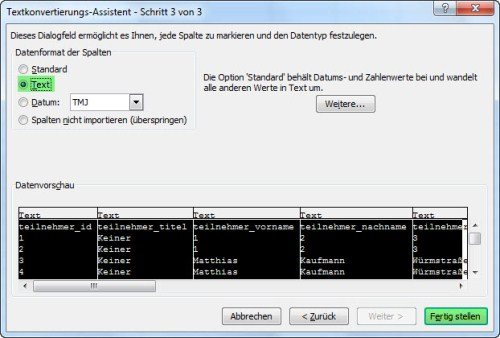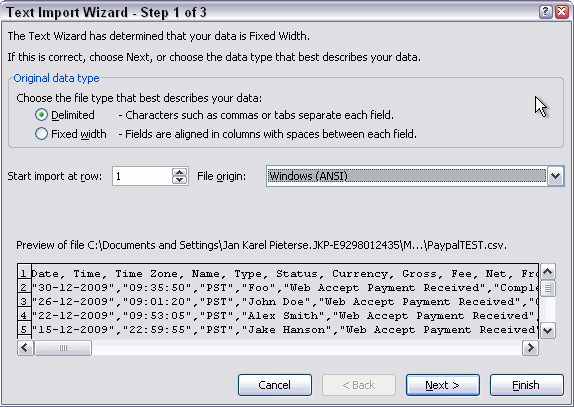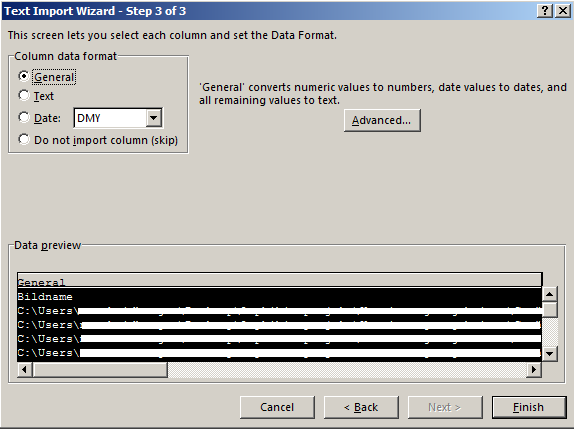

In most cases, you can leave this setting at its default. Start import at row Type or select a row number to specify the first row of the data that you want to import.įile origin Select the character set that is used in the text file. If all of the items in each column are the same length, select Fixed width. Original data type If items in the text file are separated by tabs, colons, semicolons, spaces, or other characters, select Delimited. If you experience formatting problems with dates or other stuff, add the "Local:=True" as described above.Go to the Data tab > Get External Data > From Text. Then, in the Import Text File dialog box, double-click the text file that you want to import, and the Text Import Wizard dialog will open.

#EXCEL TEXT IMPORT WIZARD ZIP#
You can download a zip compressed example spreadsheet here, and the zipped file also contains a sample text file (with semicolon as delimiter) to play with. I just click a button to execute, and the text file's data is put into another spreadsheet without "compromising" the one with the macro. I import a lot of text files and to facilitate things I have a spreadsheet with a macro almost identical to the one above. 'Just to show how, we auto fit the width of column A. Other:=False, TrailingMinusNumbers:=True, _ Semicolon:=True, Comma:=False, Space:=False, _ Workbooks.OpenText Filename:=vFileName, _ĬonsecutiveDelimiter:=False, Tab:=False, _ On your local settings and Excel version, but 'I recently discovered that you can avoid '"Semicolon:=True" to "Semicolon:=False" and set the

'another delimiter than semicolon, you must change 'We now import the selected text file, and data is If vFileName = False Or Right(vFileName, 3) "txt" Then 'If the user pressed Cancel or didn't select a text file, we exit. VFileName = Application.GetOpenFilename("Text Files (*.txt),*.txt") If you omit the file filter, all files will show. 'Here we use a filter to display only text files with "*.txt" as 'The function GetOpenFileName gets the file name without 'Import a text file using Excel's own import function.
#EXCEL TEXT IMPORT WIZARD CODE#
If you are viewing this page on a device with a small screen, some code lines will probably be broken/wrapped, but if you copy and paste into a VBA module, it should be okay with the right linebreaks.
#EXCEL TEXT IMPORT WIZARD ZIP FILE#
The zip file also contains a semicolon delimited text file for you to play with. Mark the text, copy with CTRL+C and insert (CTRL+V) into a VBA module - or download a zipped example. It allows the user to select a file without actually opening it, and we store the file name and path in a variable, which we use instead of "C:\textexample.txt". To get a file name selected by the user we use the function "Application.GetOpenFilename". To use the macro for other files we need to replace "C:\textexample.txt" with the path to a file selected by the user, and we don't need the file specific "FieldInfo. Tab:=False, Semicolon:=True, Comma:=False, Space:=False, _ TextQualifier:=xlDoubleQuote, ConsecutiveDelimiter:=False, _ Origin:=xlMSDOS, StartRow:=1, DataType:=xlDelimited, _ Workbooks.OpenText Filename:="C:\textexample.txt", _ ' Makro indspillet 13-07-2013 af Eric Bentzen


 0 kommentar(er)
0 kommentar(er)
